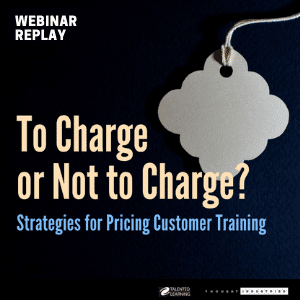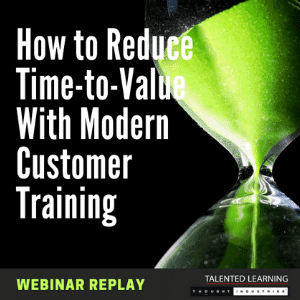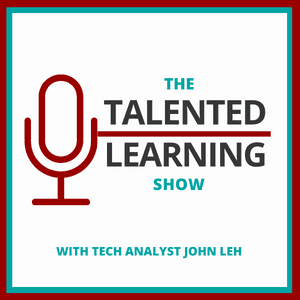
Podcast: Play in new window | Download
Subscribe: Apple Podcasts | Spotify | Amazon Music | Android | iHeartRadio | Blubrry | Email | RSS
WELCOME TO EPISODE 15 OF THE TALENTED LEARNING SHOW!
To learn more about this podcast series or to see the full collection of episodes visit The Talented Learning Show main page.
EPISODE 15 – TOPIC SUMMARY AND GUEST:
I’m excited for today’s discussion because it focuses on one of my favorite topics – customer learning strategies and technologies.
Our guest is Barry Kelly, CEO and Co-Founder of Thought Industries – one of the first and now leading extended enterprise learning solutions. Barry is a passionate innovator with proven product development success and extensive experience in elearning, digital strategy and social media marketing.
KEY TAKEAWAYS:
- For product and services companies alike, customer success drives the length and profitability of customer relationships.
- Customer training directly influences product adoption and ultimately, customer success.
- High-quality training teaches customers not only how a product works, but also how to achieve relevant business objectives.
Q&A HIGHLIGHTS:
Barry, when I discovered your company, I knew I’d found kindred spirits. Maybe you should start by telling us why you founded Thought Industries…
We’ve been around just over 5 years. Originally, we wanted to build a platform that enables organizations to deliver extended enterprise learning.
I’ve been in this industry for 20 years, and in the past, I found that when companies wanted to get a learning business off the ground, they had two choices – they could build something from the ground up, or start with an existing LMS and bolt on lots of different types of technologies.
Our vision was to bring all those things together in one solution. That includes things like microsites, storefronts, ecommerce, licensing and the ability to author courses right in the browser.
What kind of use cases do you see?
We focus on two market segments:
1) Learning Businesses: We enable for-profit organizations to create and license learning content to large organizations, or sell it directly at scale. This includes training companies and consulting firms, as well as associations that provide continuing education and certification programs for many different industries, from aviation to healthcare.
2) Customer Training Organizations: We also serve software companies – SaaS companies in particular – that want to do a better job of training their customers. The process of training and behavior change is strongly correlated with customer retention and reduced customer churn.
That’s very important for subscription software companies, where customers pay monthly or annually. Customers need to see value in a product, and that requires training.
It seems every industry should be training customers to some degree. Why do you mention SaaS companies, specifically?
Certainly, any product 0r service company may find it beneficial to educate their customers. But I would that say a much higher percentage of software companies offers customer training than any other kind of business,
Why is that?
We’re a SaaS company ourselves, so we face a lot of the same challenges our customers do. With SaaS technology, you frequently release new features. You want customers to get value for your technology, and “value” means that they have a successful experience.
Customers stay longer when they get more benefit from a product. It increases their technology usage and prevents churn. Ultimately, most SaaS companies are working towards managing that big Mac Daddy metric called churn.
What does “churn” look like?
It’s like a faucet. If customers aren’t seeing success from it, they can turn it off at any time. That’s why we’re seeing massive growth in the customer success industry, with platforms like Gainsight, ClientSuccess, Totango and ChurnZero.
These products help manage customer success across the lifecycle. We fit-in by delivering learning experiences that drive behavior change needed for customer success.
So how do organizations measure if training is actually working?
Great question. I think we should start by looking at points in the lifecycle that are critical to customer success, engagement and growth.
The first is onboarding. For SaaS products offered on a trial basis, customers need to gain proficiency very quickly.
Even with a longer onboarding process, it’s critical to configure the software so you help customer organizations succeed quickly.
There’s a related metric called time-to-value, which defines customer success in various ways. It can be based on increasing customer revenue, or improving email campaign conversions or another relevant business performance indicator.
And how does customer training have impact on time-to-value? There’s a very specific, simple way to look at it. If you deliver training on a one-to-one basis, customer success takes a lot of time, it’s costly and it’s hard to scale.
The goal with an integrated learning experience is to scale customer onboarding at a much faster rate – ideally immediately when they first engage with your SaaS product.
Is onboarding where customer training should focus?
With B2B software, it’s important to keep in mind that personnel changes are constantly happening in customer organizations. For example, when a customer first subscribed to your financial software, you onboarded their entire accounting team. But over time, many of those team members have moved on to other jobs.
Whenever a user is replaced, there’s risk. Onboarding needs to continue without disrupting operations. So the challenge is, how do you continuously influence behavior change among thousands or hundreds of thousands of users?
That’s a huge challenge…
Yes. In addition, it’s very important to remember that there are two types of customer learning experiences:
1) Contextual Learning: This focuses on becoming proficient with relevant features.
For example, teaching a user which button to press, when to select that button and when to hit return. In an email marketing system, that could include steps like, “Enter a header here. Enter body copy here. Enter a call to action here. Then press send.”
2) Application Learning: This is about helping customers apply a product successfully. In this case, it’s about how to create and manage effective email campaigns.
That’s an important distinction…
Yes. Customer success isn’t just about learning how to use technology, but how to be successful with it. In this case, it could be things like, “Create a snappy subject line with X characters. Write body copy that’s no longer than Y words. Make sure keyword density is at least Z%. Segment lists by relevant interests. And always send on Tuesday morning.”
These behaviors may not directly focus on your product, but they do help customers put your product to good use. And that’s the key to customer success, retention and growth.
So, what metrics tie training to customer success?
You can begin to understand the impact of customer training by measuring churn. For example, you can create a specific onboarding learning path and we can certify it. Then when a new user completes the process, you’ll know they’re more likely to succeed with your product.
In addition to churn, we look at what we call negative churn, which is essentially your ability to grow your client base.
You want product usage to increase because more customers know how to use your product and they’re more successful when putting it to use.
There are other types of engagement data, too. It’s a fascinating world. And we’re excited to be at the heart of this behavior change through training. We see a lot of growth potential in this area.
Exactly how do you connect these dots? How do you prove customer training ROI?
It’s about blending training data and product engagement data – focusing on specific milestones and event triggers in your product. For example, with the email product, maybe the measure of success is an X% increase in campaign clickthrough rates, or perhaps users who send at least 25 emails within 3 months of onboarding are Y% more likely to be retained or to grow as a customer. SaaS companies know these usage engagement metrics.
Interesting…
We can correlate a user’s training engagement very specifically with their product use and success. And that’s where the rubber meets the road. In our example case, the training goal is to make sure a user understands core email marketing strategies.
We can analyze all sorts of training data from that. For example, how engaged are they? Which content modules do they interact with? How do they move through the path? Have they been onboarded successfully? Have we certified them?
Those are big questions. What kind of LMS features are needed to drive customer training and provide useful customer success data?
There are multiple components. For example:
1) First, you need authoring capabilities to create high-quality content and stitch all the various learning elements together seamlessly in a very efficient way.
2) Commerce is obviously critical, especially for customer training programs that operate as profit centers.
3) The ability to embed learning technologies inside of third-party software is essential to support the contextual product learning we discussed earlier.
4) And of course, reporting is a must. Organizations need advanced tools to analyze and manipulate customer training and business data in whatever way they need.
So the features may be the same, but their application makes a customer learning platform different. Why not use the same platform for all audiences?
When choosing a learning platform of any type, you want to look around a user conference and see other like-minded individuals with similar business needs. If you choose a generic LMS, the roadmap will be much broader and less relevant to you.
That’s why focus is important. In the last 5 or 10 years, there are so many more niche learning applications. And I think that’s good for the industry…








